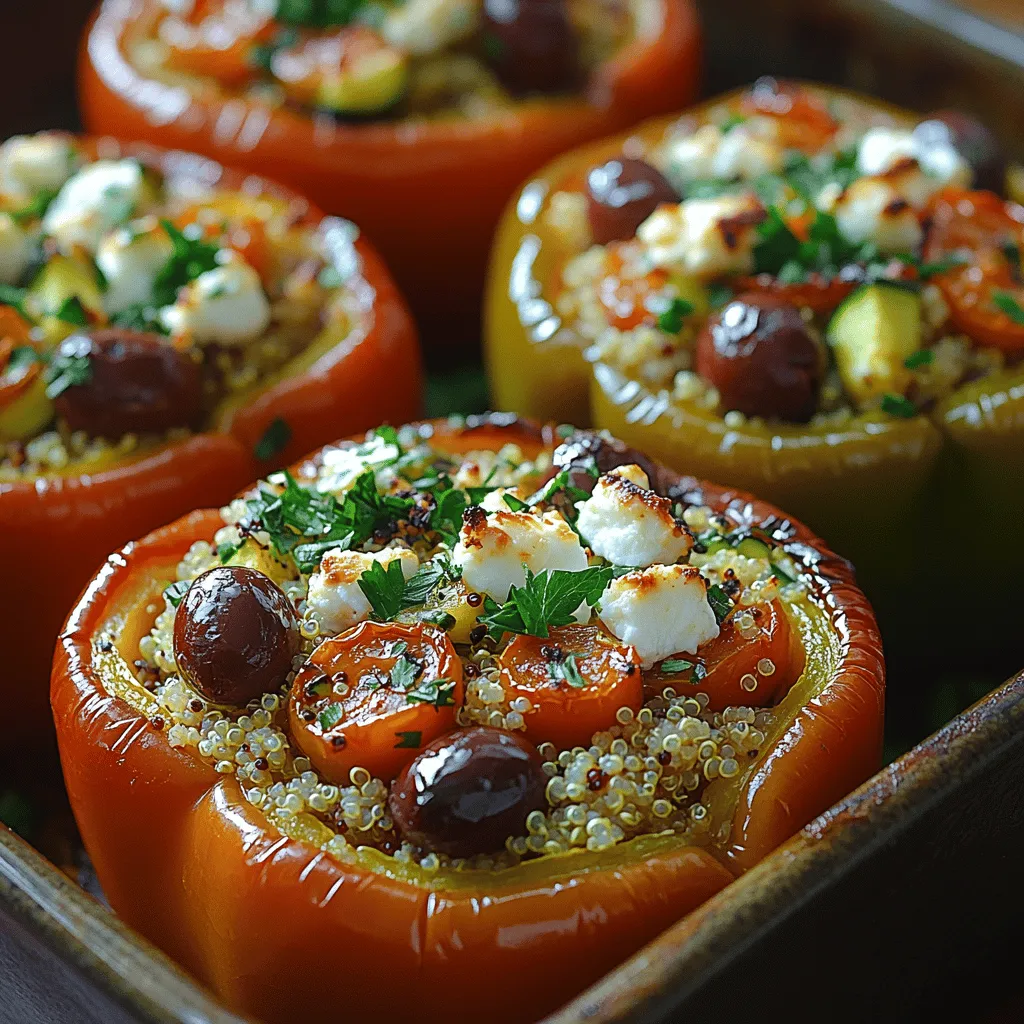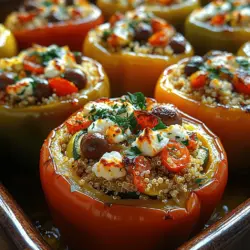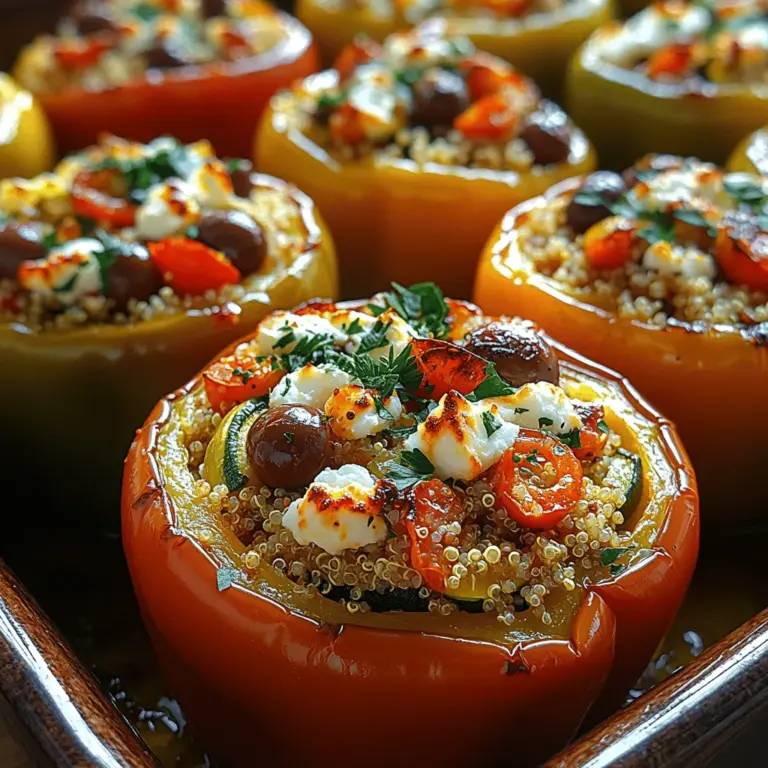Introduction
Mediterranean cuisine is renowned not only for its vibrant flavors but also for its impressive health benefits. This culinary tradition, originating from countries bordering the Mediterranean Sea, emphasizes fresh ingredients, wholesome grains, and healthy fats, making it a cornerstone of balanced diets. Rich in fruits, vegetables, whole grains, fish, and healthy oils, Mediterranean diets are linked to various health benefits, including improved heart health, reduced inflammation, and better cognitive function.
One of the most versatile and nutritious ingredients found in Mediterranean cooking is quinoa. This ancient grain has gained popularity worldwide for its remarkable nutrient profile, being a complete protein source that is also gluten-free. Quinoa is packed with essential amino acids, fiber, vitamins, and minerals, making it an ideal choice for those seeking nutritious meal options.
In the realm of meal preparation, stuffed peppers stand out as a fantastic option. Not only are they visually appealing, but they also provide a convenient and delicious way to incorporate various ingredients into a single dish. The combination of colorful bell peppers filled with a hearty and flavorful mix of quinoa, vegetables, and spices creates a satisfying meal that is both nutritious and filling.
This Mediterranean Quinoa Stuffed Peppers recipe embodies the essence of healthy cooking while being easy to prepare. Bursting with flavor and vibrant colors, these stuffed peppers make for a delightful main course or a side dish that will impress family and friends alike. Ideal for meal prep, they can be made in advance and reheated for a quick and nutritious meal during busy weeknights.
Understanding the Ingredients
Bell Peppers
Bell peppers are a staple in Mediterranean cooking, known for their sweet, crisp texture and vibrant colors. These vegetables are not only visually appealing but also packed with nutrients. They are rich in vitamins A and C, which are essential for maintaining healthy skin and boosting the immune system. Additionally, bell peppers are high in antioxidants, such as flavonoids and carotenoids, which help combat oxidative stress in the body. Their natural sweetness complements the savory flavors of the stuffing, making them a perfect vessel for our quinoa filling.
Quinoa
Quinoa is often hailed as a superfood due to its impressive nutritional profile. Unlike many grains, quinoa is a complete protein, meaning it contains all nine essential amino acids that the body cannot produce on its own. This makes it an excellent choice for vegetarians and vegans looking to boost their protein intake. Quinoa is also gluten-free, making it suitable for those with gluten sensitivities or celiac disease. Additionally, it is high in fiber, which aids in digestion and promotes a feeling of fullness. This nutritious grain serves as the base for our stuffed peppers, providing a hearty and satisfying filling.
Olive Oil
A cornerstone of Mediterranean cuisine, olive oil is celebrated for its health benefits and rich flavor. Rich in monounsaturated fats, particularly oleic acid, it has been linked to reduced risk of heart disease and improved heart health. Olive oil is also packed with antioxidants and anti-inflammatory properties, making it a smart choice for enhancing overall wellness. In this recipe, a drizzle of high-quality olive oil will help to sauté the vegetables and enhance the flavors of the stuffing.
Onions and Garlic
Onions and garlic are essential ingredients in Mediterranean cooking, adding depth and flavor to dishes. Onions are a good source of vitamins C and B6, as well as antioxidants that promote heart health. Garlic, known for its potent medicinal properties, is rich in allicin, which has been shown to boost the immune system and may help reduce blood pressure. Together, these aromatic ingredients create a savory base for the quinoa filling and contribute to the overall flavor profile of the dish.
Fresh Vegetables
In addition to quinoa and peppers, this recipe incorporates fresh vegetables like zucchini and cherry tomatoes. Zucchini is low in calories and high in vitamins A and C, along with fiber, making it a nutritious addition that adds moisture and texture to the stuffing. Cherry tomatoes, bursting with sweetness, are rich in lycopene, an antioxidant linked to numerous health benefits. These fresh vegetables not only enhance the nutritional value of the dish but also contribute to its vibrant colors and flavors.
Kalamata Olives
Kalamata olives are a staple in Mediterranean cuisine, providing a briny, rich flavor that complements the other ingredients beautifully. They are a good source of healthy fats and antioxidants, particularly vitamin E, which can help protect against oxidative stress. In our stuffed peppers, chopped Kalamata olives add a savory and slightly tangy element that enhances the overall flavor of the dish.
Oregano and Basil
Herbs like oregano and basil are essential in Mediterranean cooking, bringing aromatic flavors and health benefits to dishes. Oregano is rich in antioxidants and has antibacterial properties, while basil is known for its anti-inflammatory effects and high levels of vitamins A and K. These herbs not only elevate the flavor of the stuffing but also contribute to the overall healthiness of the dish.
Feta Cheese
Feta cheese is a traditional Mediterranean ingredient known for its tangy flavor and crumbly texture. Made from sheep’s or goat’s milk, it is lower in fat than many other cheeses and contains beneficial nutrients like calcium and protein. In this recipe, crumbled feta cheese adds a creamy element and a burst of flavor to the stuffing. For those with dietary restrictions, alternatives such as vegan feta or omitted cheese can be used without sacrificing the dish’s appeal.
Importance of Fresh and High-Quality Ingredients
When preparing Mediterranean Quinoa Stuffed Peppers, the importance of using fresh and high-quality ingredients cannot be overstated. Fresh vegetables, whole grains, and quality oils not only enhance the flavor of the dish but also ensure that you are benefiting from their nutritional properties. Opt for organic produce when possible, and select whole-grain quinoa for the best taste and health benefits. By prioritizing fresh ingredients, you will create a dish that not only looks and tastes incredible but also nourishes your body.
Step-by-Step Preparation Guide
Prepping the Oven and Ingredients
Before diving into the cooking process, it’s essential to prepare your workspace and gather all the necessary ingredients. Begin by preheating your oven to 375°F (190°C). Preheating the oven is crucial for ensuring even cooking, allowing your stuffed peppers to bake to perfection without becoming mushy or undercooked.
Next, prepare your ingredients. Rinse 1 cup of quinoa under cold water in a fine-mesh strainer to remove any bitterness from the outer coating, known as saponin. This step is vital to achieving a clean and pleasant taste. After rinsing, place the quinoa into a medium saucepan with 2 cups of water or vegetable broth. Cooking the quinoa in broth can enhance its flavor, adding an extra depth to the final dish.
Cooking the Quinoa
Bring the quinoa and liquid to a boil over medium-high heat, then reduce the heat to low, cover the saucepan, and let it simmer for about 15 minutes or until all the liquid is absorbed. To achieve fluffy quinoa, avoid stirring it while it’s cooking. Once done, remove the saucepan from heat and let it sit, covered, for an additional 5 minutes. This resting period allows the quinoa to steam, ensuring it becomes light and fluffy.
For added flavor, consider using vegetable broth or even a splash of lemon juice in the cooking liquid. This can impart a subtle yet delicious taste to the quinoa that enhances the overall dish.
Preparing the Bell Peppers
While the quinoa is cooking, it’s time to prepare the bell peppers. Choose vibrant and firm peppers, ensuring they are free from blemishes. Cut the tops off the peppers and carefully remove the seeds and membranes using a spoon or a knife. For a visual guide, you can look for instructional videos online that show the best techniques for hollowing out bell peppers.
After hollowing out the peppers, brush the insides with a little olive oil. This not only adds flavor but also helps prevent the peppers from drying out during baking.
Sautéing the Vegetables
In a large skillet over medium heat, add a tablespoon of olive oil, allowing it to warm up. Next, add diced onions and minced garlic, sautéing for about 2-3 minutes until they become fragrant and translucent. This aromatic base will provide a wonderful foundation for the flavors of your stuffed peppers.
Once the onions and garlic are ready, introduce the diced zucchini and chopped cherry tomatoes, cooking for an additional 5-7 minutes until they soften. If you prefer a little extra heat, consider adding a pinch of red pepper flakes at this stage for a subtle kick. Don’t forget to stir in the chopped Kalamata olives and fresh herbs, oregano, and basil, ensuring they are evenly distributed throughout the mixture.
Now, add the cooked quinoa to the skillet, mixing well to combine all the ingredients. Crumble in the feta cheese (or your chosen alternative) and season the mixture with salt and pepper to taste.
This filling should now be vibrant, aromatic, and packed with flavor, perfectly suited for stuffing into your prepared bell peppers.
—
This detailed guide sets the stage for creating delicious Mediterranean Quinoa Stuffed Peppers, showcasing the rich flavors and health benefits of each ingredient. With the initial preparations outlined, you’re well on your way to crafting a meal that embodies the essence of Mediterranean cuisine. Stay tuned for more instructions on assembling and baking these delightful stuffed peppers!

Best Practices for Sautéing: Temperature and Timing
When preparing the filling for your Mediterranean Quinoa Stuffed Peppers, mastering the art of sautéing is crucial. The right temperature and timing can significantly enhance the flavors of your dish. Start with medium heat, allowing your olive oil to heat up without smoking. A temperature that’s too high can lead to burnt vegetables, while too low may result in a soggy texture.
As you sauté the onions and garlic, aim for a gentle sizzle rather than an aggressive fry. This method allows the vegetables to soften and release their natural sugars, creating a sweet base for your filling. Stir frequently to ensure even cooking and prevent any sticking or burning, usually around 5-7 minutes should suffice for softening your onions and garlic to a translucent finish.
How to Enhance Flavors Through the Cooking Process
Flavor enhancement is an essential part of cooking, especially when combining various ingredients. For your filling, consider adding spices and herbs at different stages of the cooking process. Start with a pinch of salt while sautéing your vegetables to draw out moisture and intensify their flavors. As the vegetables soften, you can introduce dried herbs like oregano, thyme, or basil, allowing them to bloom in the heat and infuse their aromas throughout the dish.
Additionally, consider a splash of balsamic vinegar or a squeeze of lemon juice towards the end of cooking to brighten the flavor profile. These acidic elements can elevate the overall taste and balance the richness of the quinoa and cheese.
Combining Ingredients
Once your vegetables are nicely sautéed and fragrant, it’s time to combine them with the cooked quinoa. Ensure that the quinoa is fluffy and has cooled slightly before mixing; this prevents the filling from becoming mushy. In a large mixing bowl, combine the sautéed vegetables with the quinoa, followed by any additional ingredients, such as diced tomatoes, olives, and feta cheese.
Mix gently but thoroughly to ensure that each spoonful contains a harmonious blend of flavors. This step is crucial for achieving that delightful Mediterranean taste in every bite.
Tips for Ensuring an Even Distribution of Quinoa and Vegetables
To achieve a balanced stuffing for your peppers, it’s essential to ensure that the quinoa and vegetables are evenly distributed. Use a spatula to fold the mixture instead of stirring aggressively, which could break down the quinoa. If you’re adding beans or lentils for extra protein, be sure to distribute these evenly as well.
To test for balance, take a small spoonful of the mixture and taste it. This will help you assess if the flavors are well combined and if any additional seasoning or ingredients are needed. Remember, this is your filling, so make it to your taste preference!
Importance of Seasoning During This Stage
Proper seasoning is critical at this stage of preparation. Taste the filling mixture before stuffing the peppers and adjust as necessary. Depending on your palate, you may want to add more salt, pepper, or spices. The filling should be flavorful on its own since the peppers will add another layer of taste during baking.
Stuffing the Peppers
Now that your filling is ready, it’s time to stuff the peppers. Begin by preparing your bell peppers by cutting the tops off and removing the seeds and membranes. Rinse them under cold water to ensure they are clean. For a more robust flavor, consider briefly blanching the peppers in boiling water for a couple of minutes. This softens them slightly and enhances their sweetness.
When it comes to stuffing, use a spoon to fill each pepper generously. Pack the filling down gently but firmly to ensure it holds its shape without overflowing. Visual cues for the right amount of stuffing include filling the peppers just to the top without creating a mound. This method not only looks appealing but also helps the filling cook evenly.
Techniques for Packing the Filling Properly Without Spilling
To pack the filling properly without spilling, you can use the back of the spoon or a small measuring cup to press the quinoa mixture into the pepper. Ensure that the filling is snug but not overly tight, as the quinoa will expand slightly during baking. This technique will help to create a cohesive stuffed pepper that holds its shape and is easy to serve.
Baking Instructions
Once stuffed, arrange the peppers upright in a baking dish. Preheat your oven to 375°F (190°C). For optimal cooking, cover the dish with aluminum foil to retain steam, which will help cook the peppers evenly and keep the filling moist. Bake for about 25-30 minutes, then remove the foil and bake for an additional 10-15 minutes.
Importance of Covering with Foil for Steam Retention
Covering the dish with foil is crucial for steam retention. This step allows the peppers to soften while ensuring that the filling cooks through without drying out. The steam helps to create that tender texture you want in your stuffed peppers. Keep an eye on them as they bake; you’ll know they’re done when the peppers are tender and slightly blistered.
What to Look for to Ensure Perfect Tenderness of the Peppers
To check for perfect tenderness, gently pierce a pepper with a fork. The fork should slide in easily but without too much resistance. If the peppers are still firm, give them a few more minutes in the oven. The goal is to achieve a balance between tender peppers and a well-cooked filling.
Garnishing and Serving
Once your Mediterranean Quinoa Stuffed Peppers are out of the oven, allow them to cool slightly before serving. For a beautiful presentation, garnish each pepper with fresh herbs such as parsley or basil. Not only does this add a pop of color, but it also enhances the flavor.
Importance of Fresh Herbs for Presentation and Flavor
Fresh herbs can elevate the dish considerably. They provide a burst of freshness that complements the rich flavors of the stuffing. Consider drizzling a bit of olive oil or balsamic glaze for an extra touch of flavor.
Ideas for Serving Suggestions and Pairings
These stuffed peppers can be served as a main dish or a side. Pair them with a simple side salad or roasted vegetables for a complete meal. A dollop of Greek yogurt or tzatziki on the side can offer a refreshing contrast to the warm peppers. If you’re looking for a more substantial meal, serve them with quinoa or couscous on the side.
Nutritional Breakdown
Understanding the nutritional value of your Mediterranean Quinoa Stuffed Peppers can help you appreciate their health benefits. Each serving typically contains:
– Calories: Approximately 250-300
– Protein: 10-15 grams
– Fats: 8-10 grams
– Carbohydrates: 40-45 grams
– Fiber: 5-7 grams
This dish provides a balanced meal, combining vegetables, whole grains, and proteins. The inclusion of quinoa adds a complete protein source, making these stuffed peppers suitable for various dietary lifestyles, including vegetarian and gluten-free.
Exploring Variations and Customizations
One of the best aspects of the Mediterranean Quinoa Stuffed Peppers is their versatility. You can customize the recipe by swapping out ingredients or adding different flavors. Here are some suggestions:
– Different Types of Cheese or Vegan Alternatives: Try swapping feta cheese for goat cheese or a dairy-free alternative for a vegan option.
– Adding More Protein: For those looking to boost their protein intake, consider adding black beans, chickpeas, or lentils to the filling.
– Seasonal Vegetable Variations: Customize the filling based on seasonal vegetables. Zucchini, spinach, or kale can be fantastic additions.
– Flavor Enhancements: Experiment with spices like smoked paprika, cumin, or harissa to give your filling an extra kick. A splash of hot sauce or a drizzle of tahini can also enhance flavors.
Conclusion
Mediterranean Quinoa Stuffed Peppers are not only a wholesome meal option, but they also allow for creativity in the kitchen. With their vibrant colors, rich flavors, and healthy ingredients, these stuffed peppers are sure to satisfy your hunger and delight your taste buds. Don’t hesitate to experiment with the recipe, adding your unique touches to make it your own. Embrace the joy of creating healthy meals that are both satisfying and delicious, and enjoy the journey of cooking with these delightful stuffed peppers!

